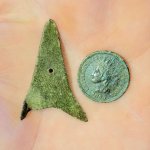- Mar 30, 2020
- 447
- 3,197
- Primary Interest:
- All Treasure Hunting
Today I loaded tick spray onto my rubber boots and got out into the woods detecting with my Manticore set to 30 sens. I was pleasantly surprised to find my fourth copper arrowhead. The other three I previously found were clustered fairly close together miles away. I donated the three previously found copper arrowheads to a regional Indian Museum as I will this one. They are quite rare finds as our contact period was mostly shortened by 1700 as an estimated 3/4's of the regional native population had tragically succumbed to smallpox. The Museum will be publishing a book "Native American Projectile Points of Eastern Long Island, NY. They asked permission to publish a page of my artict finds in the book which I readily agreed to.
I thought it ironically appropriate to find an 1864 IHP right after Memorial Day weekend. I often think of the American tragedy of the Civil War. This area has given me several IHP from the Civil War period.
The ticks weren't bad in the mature forest. Despite plenty of rain, the forest floor is desiccated from the the large trees evaporating the water out through their leaves. The ticks are mostly in town on people's irrigated lawns. I see this play out every year.
I thought it ironically appropriate to find an 1864 IHP right after Memorial Day weekend. I often think of the American tragedy of the Civil War. This area has given me several IHP from the Civil War period.
The ticks weren't bad in the mature forest. Despite plenty of rain, the forest floor is desiccated from the the large trees evaporating the water out through their leaves. The ticks are mostly in town on people's irrigated lawns. I see this play out every year.
Attachments
Upvote
35






